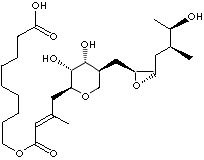PRODUCT IDENTIFICATION

TOXICITY
H.S. CODE
CLASSIFICATION
Anti-Infective, Antibacterial,
EXTRA NOTES
Antibiotic; inhibits isoleucyl-tRNA synthetase (IRS).
A topically used antibiotic from a strain of Pseudomonas fluorescens. It has
shown excellent activity against gram-positive staphylococci and streptococci.
The antibiotic is used primarily for the treatment of primary and secondary skin
disorders, nasal infections, and wound healing. Pseudomonic acid; Pseudomonic
acid A;
PHYSICAL AND CHEMICAL PROPERTIES
white to off-white powder
REFRACTIVE INDEX
NFPA RATINGS
Health hazard: 1, Fire: 0, Reactivity Hazard: 0
AUTOIGNITION
FLASH POINT
EXTERNAL LINKS & GENERAL DESCRIPTION
Drug Information Portal (U.S. National Library of Medicine) - Mupirocin
PubChem Compound Summary - Mupirocin
http://www.antimicrobe.org/
Brand names/Manufacturer:
- BACROCIN (ICN - BRAZIL)
- BACTODERM (Agis - ISRAEL)
- BACTROBAN (SmithKline Beecham – USA, CANADA, UK, IRELAND, NETHERLANDS, SOUTH AFRICA, FRANCE, BELGIUM, SPAIN, SWEDEN, AUSTRIA, SWITZERLAND, ITALY, AUSTRALIA, DENMARK, BRAZIL, JAPAN, HONG KONG, MEXICO, ISREAL, THAILAND, SINGAPORE, FINLAND, NEW ZEALAND, MALAYSIA, PORTUGAL, GREECE, CHILE, HUNGARY, CZECH REPUBLIC)
- BACTRONEO (Neo Quimica - BRAZIL)
- CELEFER (Smith Kline - Spain)
- CENTANY (Ortho - USA)
- EISMYCIN (GlaxoSmithKline - GERMANY)
- EISMYCIN (SmithKline - GERMANY)
- HEVRONAZ (Rafarm - GREECE)
- INFECTOPYODERM (Infectopharm - GERMANY)
- MICOBAN (Genepharm - GREECE)
- MUPIDERM (Pharmafarm - FRANCE)
- MUPIROCIN (Teva - USA)
- MUPORIN (TO-Chemicals - THAILAND)
- PLASIMINE (Isdin - SPAIN)
- TURIXIN (GlaxoSmithKline - GERMANY)
- ULTRABIOTIC (Bago - CHILE)
- UNDERAN (Saval - CHILE)
- VELTION (Faran - GREECE)
http://www.pnas.org/
Intraerythrocytic malaria parasites can obtain nearly their entire amino acid
requirement by degrading host cell hemoglobin. The sole exception is isoleucine,
which is not present in adult human hemoglobin and must be obtained exogenously.
We evaluated two compounds for their potential to interfere with isoleucine
utilization. Mupirocin, a clinically used antibacterial, kills Plasmodium
falciparum parasites at nanomolar concentrations. Thiaisoleucine, an
isoleucine analog, also has antimalarial activity. To identify targets of the
two compounds, we selected parasites resistant to either mupirocin or
thiaisoleucine. Mutants were analyzed by genome-wide high-density tiling
microarrays, DNA sequencing, and copy number variation analysis. The genomes of
three independent mupirocin-resistant parasite clones had all acquired either
amplifications encompassing or SNPs within the chromosomally encoded organellar
(apicoplast) isoleucyl-tRNA synthetase. Thiaisoleucine-resistant parasites had a
mutation in the cytoplasmic isoleucyl-tRNA synthetase. The role of this mutation
in thiaisoleucine resistance was confirmed by allelic replacement. This approach
is generally useful for elucidation of new targets in P. falciparum.
Our study shows that isoleucine utilization is an essential pathway that can be
targeted for antimalarial drug development.
http://www.pidsphil.org/
THE
EFFECT OF TOPICAL APPLICATION OF MUPIROCIN IN INTRAVENOUS CATHETER
SITE IN THE INCIDENCE OF SUPERFICIAL PHLEBITIS
http://www.nature.com/
Mupirocin,
a polyketide antibiotic produced by Pseudomonas fluorescens, is
used to control the carriage of methicillin-resistant Staphylococcus
aureus on skin and in nasal passages as well as for various skin
infections. Low-level resistance to the antibiotic arises by mutation
of the mupirocin target, isoleucyl-tRNA synthetase, whereas high-level
resistance is due to the presence of an isoleucyl-tRNA synthetase
with many similarities to eukaryotic enzymes. Mupirocin biosynthesis
is carried out by a combination of type I multifunctional polyketide
synthases and tailoring enzymes encoded in a 75 kb gene cluster.
Chemical synthesis has also been achieved. This knowledge should
allow the synthesis of new and modified antibiotics for the future.
APPEARANCE
white to off-white powder
IDENTIFICATION
passes Test
PURITY
92.0% ~ 102.0%
pH
3.0 ~ 4.5
OPTICAL ROTATION
-20° ~ -16°
IMPURITY
Individual impurity 1.0% max
Total impurity: 5.0% max
RESIDUAL SOLVENTS
Ethyl
Acetate 0.5% max
Isobutyl Acetate 0.5% max
Heptane 0.5% max
Acetone
0.5% max
WATER
1.0% max
HEAVY METALS
20ppm max